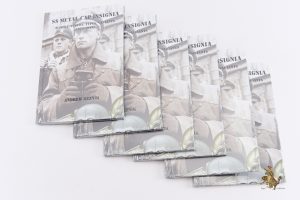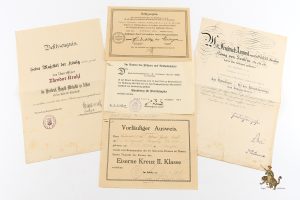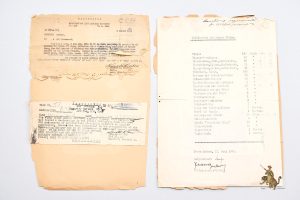Date: April 19 1934
Serial Number: K/134 45700
Grade: PMG Uncirculated 62
PMG: 2358306-002.
Sold
Product Description: Discover a stunning artifact from one of the boldest espionage missions of WWII: Operation Bernhard. This counterfeit £10 note, meticulously forged by Jewish prisoners in the Sachsenhausen concentration camp in their effort to destabilize the British economy, represents a piece of history shrouded in intrigue, strategy, and craftsmanship. This PMG Uncirculated 62 note which has been graded by Paper Money Grading scale PMG uses a 70-point numerical scale for their grading. This WWII German Operation Bernhard Counterfeit £10 Note is a pristine example, preserved in remarkable condition. The uncirculated note with just a spot of rust staining on the top edge from its time underwater, part of a consecutive group as originally found. Its sharp details, crisp paper, and near-perfect presentation make it a show-stopper in any collection. With the serial number K/134 45700 and the date April 19 1934, this note is more than a counterfeit—it’s a story frozen in time. This is not just a banknote—it’s a tangible connection to one of WWII’s most ambitious covert operations. These notes were created with extraordinary attention to detail, making them indistinguishable from genuine currency to all but the most trained eyes. Whether you’re a seasoned numismatist or a WWII history collector, this counterfeit note is a must have for any collection. Its rarity, combined with its historical intrigue, makes it a conversation-starting centerpiece. Operation Bernhard counterfeit notes in this condition rarely appear on the market. They have also made a fantastic movie about this called The Counterfeiters (2007) which tells the true story of Operation Bernhard, a Nazi plan to destabilize Allied economies by forging currency. Salomon Sorowitsch, a Jewish forger in a concentration camp, is forced to lead a team of prisoners in producing counterfeit money, facing moral dilemmas and struggles for survival. The film won the 2008 Academy Award for Best Foreign Language Film. Don’t miss your chance to own a WWII German Operation Bernhard Counterfeit £10 Note that blurs the line between war and deception—a true gem for the discerning collector.
Note: This note is sold as a historical artifact and does not carry legal tender status.
Historical Description: Operation Bernhard was an exercise by Nazi Germany to forge British bank notes. The initial plan was to drop the notes over Britain to bring about a collapse of the British economy during the Second World War. The first phase was run from early 1940 by the Sicherheitsdienst (SD) under the title Unternehmen Andreas (Operation Andreas). The unit successfully duplicated the rag paper used by the British, produced near-identical engraving blocks and deduced the algorithm used to create the alpha-numeric serial code on each note. The unit closed in early 1942 after its head, Alfred Naujocks, fell out of favour with his superior officer, Reinhard Heydrich. The operation was revived later in the year; the aim was changed to forging money to finance German intelligence operations. Instead of a specialist unit within the SD, prisoners from Nazi concentration camps were selected and sent to Sachsenhausen concentration camp to work under SS Major Bernhard Krüger. The unit produced British notes until mid-1945; estimates vary of the number and value of notes printed, from £132.6 million up to £300 million. By the time the unit ceased production, they had perfected the artwork for US dollars, although the paper and serial numbers were still being analysed. The counterfeit money was launderedin exchange for money and other assets. Counterfeit notes from the operation were used to pay the Turkish agent Elyesa Bazna—code named Cicero—for his work in obtaining British secrets from the British ambassador in Ankara, and £100,000 from Operation Bernhard was used to obtain information that helped to free the Italian leader Benito Mussolini in the Gran Sasso raid in September 1943. In early 1945 the unit was moved to Mauthausen-Gusen concentration camp in Austria, then to the Redl-Zipf series of tunnels and finally to Ebensee concentration camp. Because of an overly precise interpretation of a German order, the prisoners were not executed on their arrival; they were liberated shortly afterwards by the American Army. Much of the output of the unit was dumped into the Toplitz and Grundlsee lakes at the end of the war, but enough went into general circulation that the Bank of England stopped releasing new notes and issued a new design after the war. The operation has been dramatised in a comedy-drama miniseries Private Schulz by the BBC and in a 2007 film, The Counterfeiters (Die Fälscher).
We are the leading team of military antique specialists. We have specialized in military antiques for over 25 years.
Epic Artifacts offers the highest prices available for your collectibles.
We purchase single items, entire collections, or family estates.
Click the link here to learn more: Inquiries
or feel free to email us directly: info@epicartifacts.com

In stock

In stock

In stock

In stock